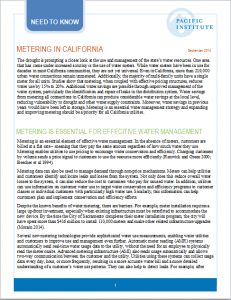Overview
This fact sheet examines the effectiveness of water metering as a tool to reduce excessive or wasteful water use by both utility companies and customers. While several California cities and municipalities have successfully implemented water metering policies, more than 219,000 customers statewide remain unmetered. Although meters have a high installation cost, they are a key conservation measure that reduces vulnerability to drought and other water supply constraints.
Metering is an essential water management strategy. Expanding and improving metering should be a priority for all California utilities. When customers are charged for their water use by volume, it is a signal to improve water conservation and efficiency habits. Metering also helps utilities identify and repair leaks in the system. Submetering of multi-family homes, which account for 31% of California’s housing units, could significantly increase water savings.
Key Findings
Key findings include:
- Metering enables utilities to use pricing to encourage water conservation and efficiency.
- Studies show that metering, when coupled with effective pricing structures, reduces water use 15-20%.
- Additional water savings are possible through improved management of the water system, particularly the identification and repair of leaks in the distribution system. Water savings from metering all connections in California can produce considerable water savings at the local level, reducing vulnerability to drought and other water supply constraints.
- While water meters have been in use for decades in most California communities, they are not yet universal. Even in California, more than 219,000 urban water connections remain unmetered. Additionally, the majority of multi-family units have a single meter for all units.
- Despite the known benefits of water metering, there are barriers. For example, meter installation requires a large up-front investment, especially when existing infrastructure must be retrofitted to accommodate the new device.
- Automatic meter reading systems automatically send real-time water usage data to the utility, without the need for an employee to physically read the meter onsite.
- Advanced metering infrastructure reads usage automatically and allows two-way communication between the customer and the utility. Utilities using these systems can collect usage data every day, hour, or more frequently, resulting in a more accurate water bill and a more detailed understanding of a customer’s water use patterns. They can also help to detect leaks.
Resources


